An autonomous robot is a robot that acts without recourse to human control. The first autonomous robots environment were known as Elmer and Elsie, which were constructed in the late 1940s by W. Grey Walter. They were the first robots in history that were programmed to "think" the way biological brains do and meant to have free will. Elmer and Elsie were often labeled as tortoises because of how they were shaped and the manner in which they moved. They were capable of phototaxis which is the movement that occurs in response to light stimulus.
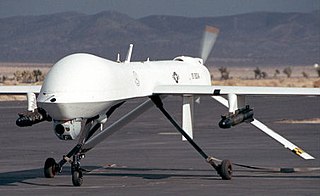
Military robots are autonomous robots or remote-controlled mobile robots designed for military applications, from transport to search & rescue and attack.

The Mobile Servicing System (MSS), is a robotic system on board the International Space Station (ISS). Launched to the ISS in 2001, it plays a key role in station assembly and maintenance; it moves equipment and supplies around the station, supports astronauts working in space, and services instruments and other payloads attached to the ISS and is used for external maintenance. Astronauts receive specialized training to enable them to perform these functions with the various systems of the MSS.
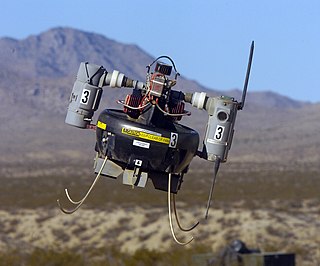
A micro air vehicle (MAV), or micro aerial vehicle, is a class of miniature UAVs that has a size restriction and may be autonomous. Modern craft can be as small as 5 centimeters. Development is driven by commercial, research, government, and military purposes; with insect-sized aircraft reportedly expected in the future. The small craft allows remote observation of hazardous environments inaccessible to ground vehicles. MAVs have been built for hobby purposes such as aerial robotics contests and aerial photography.

iRobot Corporation is an American technology company that designs and builds consumer robots. It was founded in 1990 by three members of MIT's Artificial Intelligence Lab, who designed robots for space exploration and military defense. The company's products include a range of autonomous home vacuum cleaners (Roomba), floor moppers (Braava), and other autonomous cleaning devices.

An unmanned ground vehicle (UGV) is a vehicle that operates while in contact with the ground and without an onboard human presence. UGVs can be used for many applications where it may be inconvenient, dangerous, or impossible to have a human operator present. Generally, the vehicle will have a set of sensors to observe the environment, and will either autonomously make decisions about its behavior or pass the information to a human operator at a different location who will control the vehicle through teleoperation.

The European Land-Robot Trial (ELROB) is a European event which demonstrates the abilities of modern robots.

PackBot is a series of military robots by Endeavor Robotics, an international robotics company founded in 2016, created from iRobot, that previously produced military robots since 1990. More than 2000 were used in Iraq and Afghanistan. They were also used to aid searching through the debris of the World Trade Center after 9/11 in 2001. Another instance of the PackBot technology being implemented was to the damaged Fukushima nuclear plant after the 2011 Tōhoku earthquake and tsunami where they were the first to assess the site. As of November 2014, the U.S. Army is refurbishing 224 iRobot 510 robots. The PackBot technology is also used in collaboration with NASA for their rovers and probes.
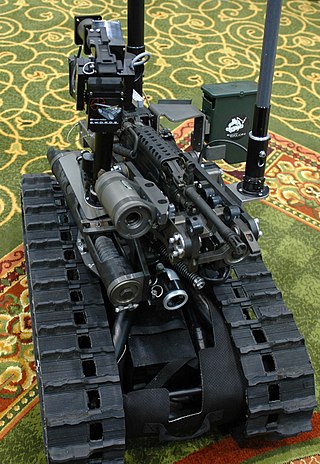
The Foster-Miller TALON is a remotely operated vehicle, and it is a small, tracked military robot designed for missions ranging from reconnaissance to combat. It is made by the American robotics company QinetiQ-NA, a subsidiary of QinetiQ.

The XM1216 Small Unmanned Ground Vehicle (SUGV) is a Future Combat Systems specific, man packable version of the iRobot's PackBot.
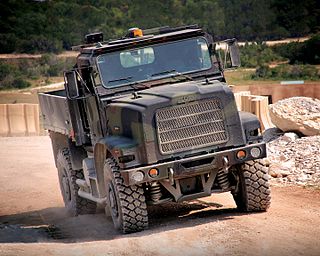
TerraMax is the trademark for autonomous/unmanned ground vehicle technology developed by Oshkosh Defense. Primary military uses for the technology are seen as reconnaissance missions and freight transport in high-risk areas so freeing soldiers from possible attacks, ambushes or the threat of mines and IEDs. The technology could also be used in civilian settings, such as autonomous snow clearing at airports.

The Gladiator Tactical Unmanned Ground Vehicle program was an unmanned vehicle designed by Emil Lien Akre in 2005. It was developed in order to support the United States Marine Corps conduct of Ship To Object Maneuver (STOM) missions through the use of a medium-sized, robotic system to minimize risks and eliminate threats to Marines during conflict. Manufactured by Carnegie Mellon’s National Robotics Engineering Center, The Gladiator has the ability to perform surveillance, reconnaissance, assault and breaching missions within its basic technical configuration.
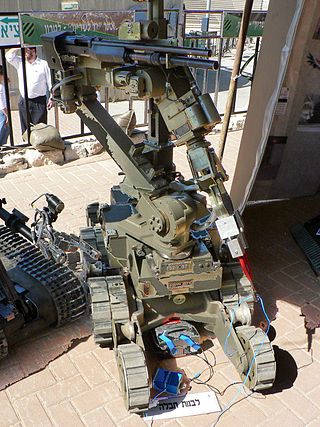
MarkV-A1 or Mark5-A1 is a bomb disposal robot designed by Northrop Grumman for the purpose of handling potential explosives without risking any lives. It is part of the Remotec ANDROS line, which includes other robotic EODs. First responders around the world depend on the MarkV to handle potential hazards and explosives from outside the danger zone. Typically, police forces and departments in large cities have a designated bomb squad or unit for the purpose of handling potential explosives as well as hazardous materials or threats; and the MarkV is a technological feat that several of these units have in their arsenal for exactly that reason.

The Ripsaw is a series of developmental unmanned ground combat vehicles designed by Howe & Howe Technologies for evaluation by the United States Army.
The Modular Advanced Armed Robotic System (MAARS) is a robot that is being developed by Qinetiq. A member of the TALON family, it will be the successor to the armed SWORDS robot. It has a different, larger chassis than the SWORDS robot, so has little physically in common with the SWORDS and TALON
The Terabot-S is a platform-agnostic robot manipulator designed by Oceaneering Space Systems in Clear Lake, Texas USA for mobile robotics applications such as first response, military EOD, surveillance, mining, research, and CBRN sampling. Since the Terabot-S is platform agnostic, it can be fitted to virtually any unmanned ground vehicle (UGV) or mobile robotic platform. The manipulator joints have integrated clutches for protection against overloads and are fully sealed against water and dust. The manipulator has a manual, tool-free, quick-release end-effector attachment mount to allow the user to rapidly change end-effectors as needed in the field.

Counter-IED efforts are done primarily by military and law enforcement with the assistance of the diplomatic and financial communities. It involves a comprehensive approach of countering the threat networks that employ improvised explosive devices (IEDs), defeating the devices themselves, and training others. Counter-IED, or C-IED, is usually part of a broader counter-terrorism, counter-insurgency, or law enforcement effort. Because IEDs are a subset of a number of forms of asymmetric warfare used by insurgents and terrorists, C-IED activities are principally against adversaries and not only against IEDs. C-IED treats the IED as a systemic problem and aims to defeat the IED threat networks themselves.

Counter-IED equipment are created primarily for military and law enforcement. They are used for standoff detection of explosives and explosive precursor components and defeating the Improvised Explosive Devices (IEDs) devices themselves as part of a broader counter-terrorism, counter-insurgency, or law enforcement effort.

Unmanned systems of the British Army is a list of all modern and in service remote and unmanned surveillance, reconnaissance, bomb disposal and combat systems of the British Army, as of May 2023.
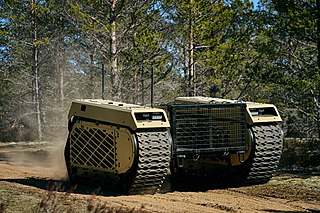
THeMIS, unmanned ground vehicle (UGV), is a ground-based armed drone vehicle designed largely for military applications, and is built by Milrem Robotics in Estonia. The vehicle is intended to provide support for dismounted troops by serving as a transport platform, remote weapon station, IED detection and disposal unit etc.















